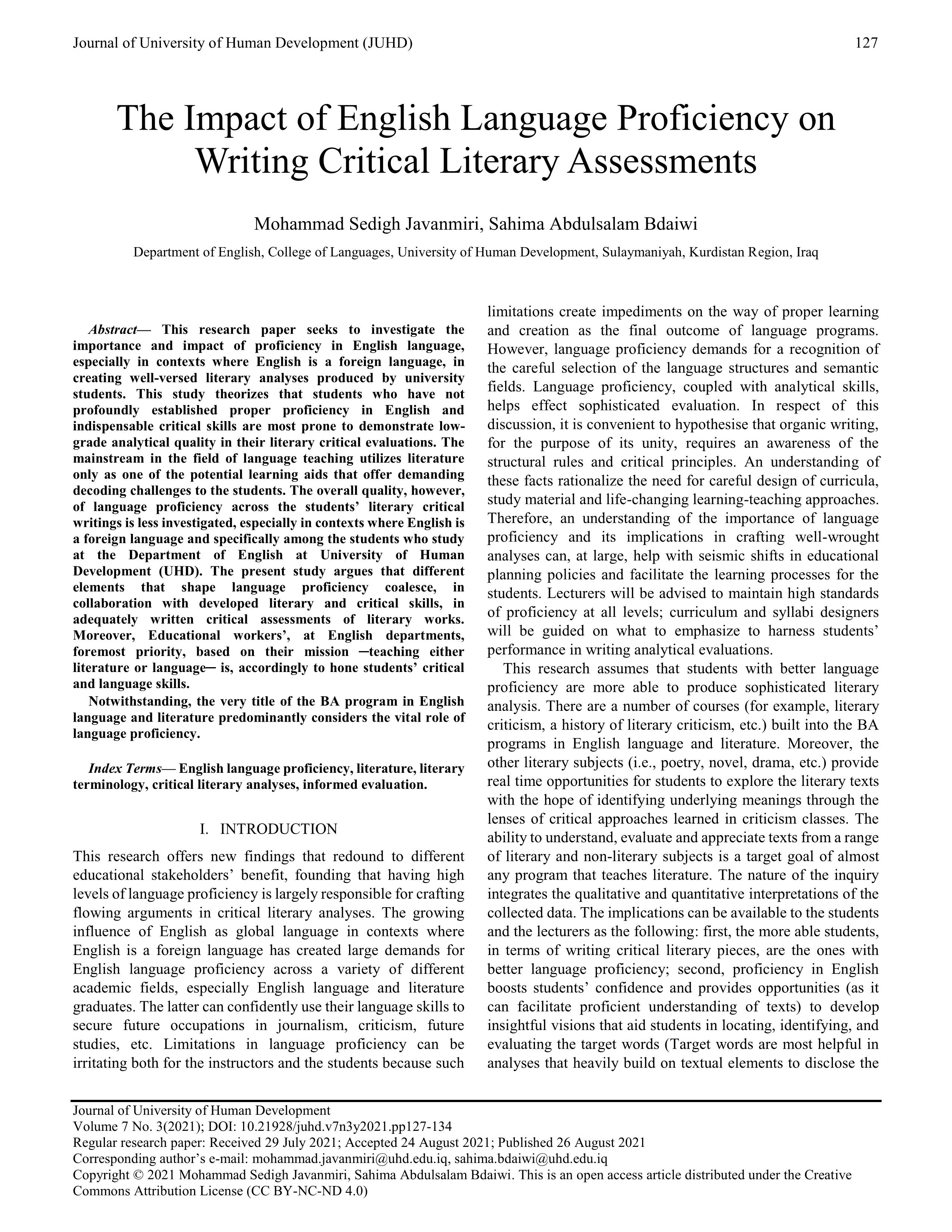The Impact of English Language Proficiency on Writing Critical Literary Assessments
DOI:
https://doi.org/10.21928/juhd.v7n3y2021.pp127-134Keywords:
English language proficiency, Literature, Literary terminology, Critical literary analyses, Informed evaluationAbstract
This research paper seeks to investigate the importance and impact of proficiency in English language, especially in contexts where English is a foreign language, in creating well-versed literary analyses produced by university students. This study theorizes that students who have not profoundly established proper proficiency in English and indispensable critical skills are most prone to demonstrate low-grade analytical quality in their literary critical evaluations. The mainstream in the field of language teaching utilizes literature only as one of the potential learning aids that offer demanding decoding challenges to the students. The overall quality, however, of language proficiency across the students’ literary critical writings is less investigated, especially in contexts where English is a foreign language and specifically among the students who study at the Department of English at University of Human Development (UHD). The present study argues that different elements that shape language proficiency coalesce, in collaboration with developed literary and critical skills, in adequately written critical assessments of literary works. Moreover, Educational workers’, at English departments, foremost priority, based on their mission ─teaching either literature or language─ is, accordingly to hone students’ critical and language skills.
Notwithstanding, the very title of the BA program in English language and literature predominantly considers the vital role of language proficiency.
References
Arnold, M., & Pater, W. (1895). The Function of Criticism at the Present Time: Macmillan.
Bertens, H. (2017). Literary Theory: The Basics: Taylor & Francis.
DEY, B. G. (2021). MORE THAN 100 WAYS OF MAKING MONEY- A Comprehensive and Practical Approach: Onlinegatha.
Eagleton, T. (2008). Literary Theory: An Introduction: University of Minnesota Press.
Earthman, E. A. (1992). Creating the Virtual Work: Readers' Processes in Understanding Literary Texts. Research in the Teaching of English, 26(4), 351-384.
Espenshade, T. J., & Fu, H. (1997). An Analysis of English-Language Proficiency among U.S. Immigrants. American Sociological Review, 62(2), 288-305. doi:10.2307/2657305
Graham, J. G. J. T. q. (1987). English language proficiency and the prediction of academic success. 21(3), 505-521.
Guerin, W. L., Labor, E., Labor, G. W. P. A. L. E., R, J., Morgan, L., Reesman, J. C., . . . Morgan, P. E. L. (2005). A Handbook of Critical Approaches to Literature: Oxford University Press.
Harsch, C. (2016). Proficiency. ELT Journal, 71(2), 250-253. doi:10.1093/elt/ccw067 %J ELT Journal
Kusch, C. (2016). Literary Analysis: The Basics: Taylor & Francis.
Leaver, B. L., & Campbell, C. (2014). Experience with Higher Levels of Proficiency. In T. Brown & J. Bown (Eds.), To Advanced Proficiency and Beyond (pp. 3-22): Georgetown University Press.
McManus, W., Gould, W., & Welch, F. J. J. o. l. E. (1983). Earnings of Hispanic men: The role of English language proficiency. 1(2), 101-130.
Miall, D. S., & Kuiken, D. (1994). Beyond text theory: Understanding literary response. Discourse Processes, 17(3), 337-352. doi:10.1080/01638539409544873
National Academies of Sciences, E. M., Division, H. M., Education, D. B. S. S., Education, B. S., Board on Children, Y. F., Committee on Fostering School Success for English Learners: Toward New Directions in Policy, P. R., . . . Takanishi, R. (2017). Promoting the Educational Success of Children and Youth Learning English: Promising Futures: National Academies Press.
Ransom, J. C. (1971). The New Criticism: Folcroft Library Editions.
Renandya, W. A., Hamied, F. A., & Nurkamto, J. J. J. o. A. T. (2018). English language proficiency in Indonesia: Issues and prospects. 15(3), 618.
Richards, J. C. (2017). Teaching English through English: Proficiency, Pedagogy and Performance. 48(1), 7-30. doi:10.1177/0033688217690059
Richards, J. C. (Writer). (2018). Communicative Competence. In.
Wood, N., & Lodge, D. (2014). Modern Criticism and Theory: A Reader: Taylor & Francis.
Earthman, E. A. (1992). Creating the Virtual Work: Readers' Processes in Understanding Literary Texts. Research in the Teaching of English, 26(4), 351-384.
Graham, J. G. J. T. q. (1987). English language proficiency and the prediction of academic success. 21(3), 505-521.
Leaver, B. L., & Campbell, C. (2014). Experience with Higher Levels of Proficiency. In T. Brown & J. Bown (Eds.), To Advanced Proficiency and Beyond (pp. 3-22): Georgetown University Press.
Miall, D. S., & Kuiken, D. (1994). Beyond text theory: Understanding literary response. Discourse Processes, 17(3), 337-352. doi:10.1080/01638539409544873

Downloads
Published
How to Cite
Issue
Section
License
Copyright (c) 2021 Mohammad Sedigh Javanmiri, Sahima Abdulsalam Bdaiwi

This work is licensed under a Creative Commons Attribution-NonCommercial-NoDerivatives 4.0 International License.


